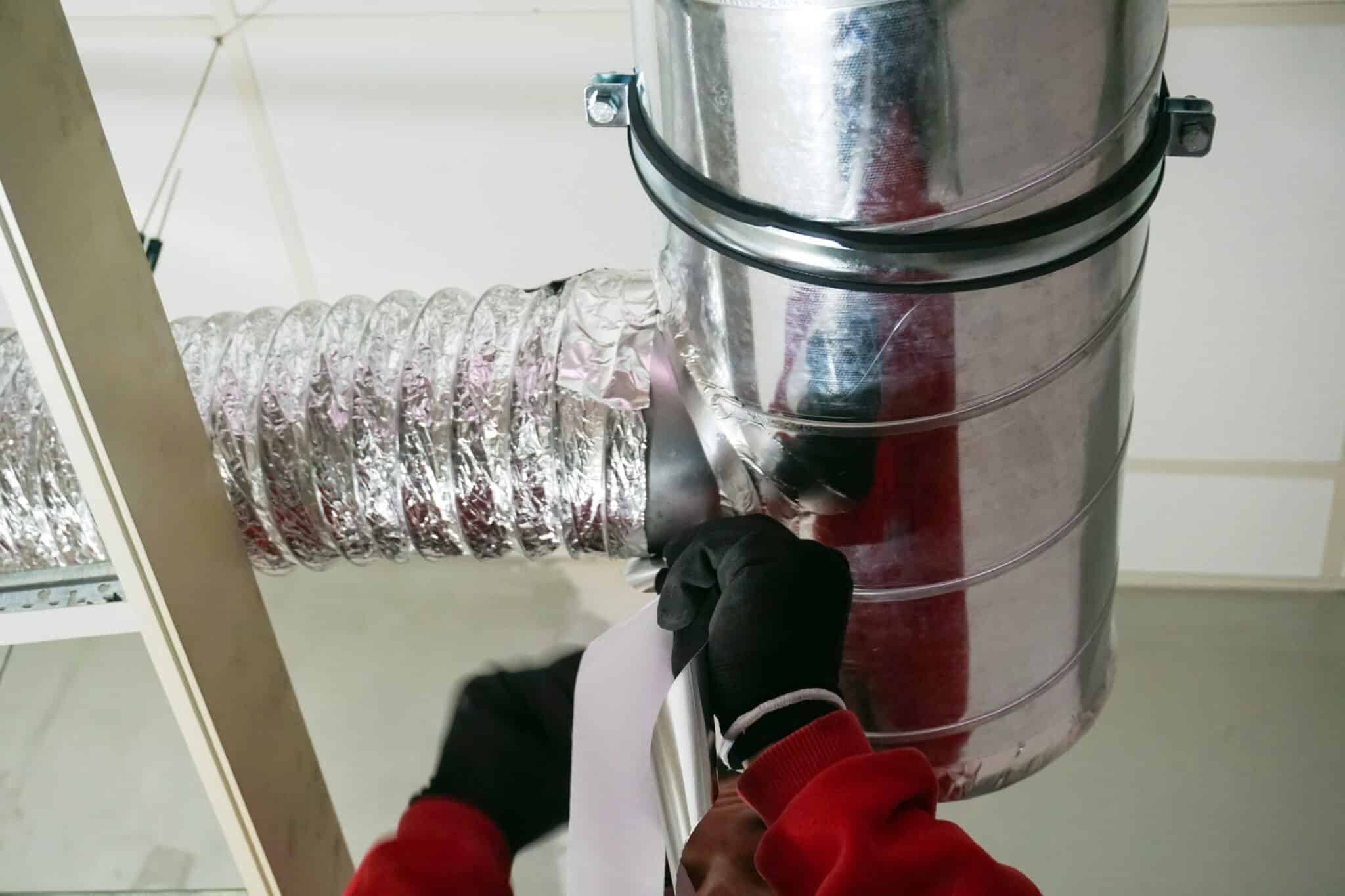
Insulating HVAC Ductwork for Optimal Performance in Texas Winters
HVAC ductwork channels warm air throughout your home, but without proper insulation, much of that heat escapes, reducing indoor comfort and driving up energy costs. In Texas, where winter cold snaps can surprise even seasoned locals, insulating your ductwork is more than an efficiency measure it is a way to ensure your home stays reliably warm without overworking your system. By keeping heat where it is needed, duct insulation can lower utility bills and maximize the performance of your HVAC system. With cooler weather arriving this November, insulation is a valuable investment in both comfort and savings.
How HVAC Ductwork Supports Home Comfort
When temperatures drop, your HVAC system works tirelessly to keep your home warm and welcoming. But there’s a hidden hero in this process: HVAC ductwork. This often-overlooked system acts as the “highway” that delivers warm air from your furnace or heat pump directly to each room, ensuring every corner of your home feels comfortable. However, without proper insulation, much of that valuable heat can escape along the way, making your heating system work harder to maintain steady temperatures.
In Texas, where winter weather can be unpredictable, duct insulation is essential for keeping warmth inside your home rather than letting it seep out through thin, uninsulated ducts. Well-insulated ductwork helps prevent sudden temperature changes, stops drafts, and contributes to lower energy bills. Different types of duct materials, such as flexible ducts, sheet metal, and fiberglass-lined ducts, offer unique benefits based on your home’s design. But regardless of material, insulation is the game-changer, preserving the temperature of the air that’s traveling through the ducts. This results in a smoother, more energy-efficient operation that can save you money over time.
Insulating your ductwork also means your HVAC system doesn’t need to run as frequently or as long, cutting down on wear and tear. As a result, not only do you get a more comfortable home, but you also protect the longevity of your heating system. By insulating your ductwork as November’s chill arrives, you invest in a more reliable, cost-effective, and comfortable home environment—one that’s ready to handle the winter months with ease.
The Importance of Insulating HVAC Ductwork
Properly insulating HVAC ductwork is essential to maximizing your home’s comfort and efficiency, especially during colder months. Uninsulated ductwork loses a significant amount of heat before it reaches the intended rooms, which means your HVAC system has to work much harder to maintain consistent warmth. This results in increased energy bills, uneven room temperatures, and unnecessary strain on your heating equipment.
In Texas, where winter temperatures can surprise with sudden cold fronts, insulated HVAC ductwork offers a crucial advantage. By keeping the warm air contained within the ducts, insulation minimizes heat loss, ensuring that each room receives the full benefit of your heating system. This leads to a cozier home environment, with fewer drafts and cold spots, all while lowering monthly energy costs.
Moreover, insulating HVAC ductwork helps prevent condensation buildup within the ducts, which can lead to mold growth and negatively impact indoor air quality. Proper insulation also reduces wear on your HVAC components, ultimately extending their lifespan and enhancing overall system reliability. For Texas homeowners, ductwork insulation is a smart, practical investment that delivers long-term comfort, health benefits, and savings. With colder weather approaching this November, insulating your HVAC ductwork is one of the most effective steps to ensure a warm, energy-efficient home.

Benefits of Ductwork Insulation in Texas Winters
For Texas homeowners, insulating HVAC ductwork is a valuable upgrade that often goes unnoticed. While Texas winters may not be as intense as those in northern states, sharp temperature drops can leave homes chilly, especially when ductwork is not insulated. Insulated ductwork not only enhances comfort but also offers a range of benefits that make a real difference during the colder months.
-
Greater Energy Efficiency
By insulating your ducts, you prevent warm air from escaping as it travels through your home. This means more of the heat generated by your HVAC system actually reaches each room, allowing the system to run more efficiently. Reduced heat loss leads to lower energy consumption, which directly translates into savings on monthly heating bills.
-
Consistent Indoor Comfort
Insulated ducts help distribute heat evenly throughout the house. Without insulation, warm air can dissipate before reaching certain rooms, creating uncomfortable cold spots and drafts. Insulation minimizes this issue, ensuring that every part of your home remains cozy, even during sudden cold snaps.
-
Enhanced Indoor Air Quality
Uninsulated ducts can be prone to condensation, which fosters mold and mildew growth. These contaminants can spread through your air, negatively impacting indoor air quality and potentially causing health issues. Insulating ductwork helps prevent moisture buildup, keeping your home’s air cleaner and healthier.
-
Extended HVAC System Life
When your HVAC system doesn’t have to compensate for heat loss, it runs less frequently and with less strain. This reduces wear on the system, leading to fewer repair needs and extending the life of your HVAC unit. Duct insulation is a proactive step that supports a durable, reliable heating system for years to come.
As November approaches, investing in duct insulation is a strategic way to improve comfort, reduce costs, and create a healthier home environment for Texas’s unpredictable winter weather.
Common Insulation Materials for Ductwork
Choosing the best insulation for HVAC ductwork can make a notable difference in your home’s comfort, energy savings, and system durability. Different materials offer unique benefits, and selecting the right one can optimize your HVAC system’s efficiency and reliability.
-
Fiberglass Insulation
Known for its high thermal resistance, fiberglass is a top choice for insulating HVAC ductwork. It comes in pre-formed sleeves that securely wrap around ducts, helping to prevent heat loss. This material not only keeps warm air where it belongs but also helps minimize noise, creating a quieter home environment. However, it’s essential to install fiberglass carefully to avoid loose particles that can affect air quality.
-
Foam Board Insulation
Foam board insulation provides a high R-value, making it effective even with thin layers. This rigid material is installed on the exterior of the ductwork, and then sealed with a vapor barrier to lock in warmth. Foam board is ideal for smaller spaces where other insulation types may not fit and is highly effective in stabilizing indoor temperatures during Texas’s unpredictable winters.
-
Radiant Barrier Insulation
Radiant barrier insulation, often made of reflective foil, works by reflecting heat rather than absorbing it. This lightweight material is especially beneficial in warmer climates but also offers winter protection by keeping heat within the ducts. Used alongside other insulation types, radiant barriers boost overall efficiency, creating a more stable indoor environment.
-
Foam Insulation Wrap
Foam insulation wrap is flexible, wrapping easily around various duct shapes and sizes. It’s particularly suitable for tight or hard-to-access areas, such as attics or crawl spaces. Foam wrap offers moderate insulation and is easy to apply, making it a practical choice for retrofitting ducts without extensive work.
The right insulation material for HVAC ductwork depends on factors like available space, noise control needs, and your local climate. Insulated ducts enhance comfort, reduce energy bills, and help prolong HVAC system life, making them a smart investment for any Texas home facing colder weather.

Signs Your Ductwork Needs Insulation
Understanding when your HVAC ductwork requires insulation can save energy, reduce heating costs, and improve indoor comfort. Properly insulated ductwork ensures that warm air reaches each room without losing heat along the way.
Uneven Room Temperatures
If some rooms are noticeably warmer or colder than others, uninsulated HVAC ductwork might be causing the inconsistency. Without insulation, heat can escape before it reaches certain areas, leading to temperature imbalances and cold spots throughout your home.
Rising Energy Bills
Unexplained increases in your energy bills may signal a need for duct insulation. When ductwork is not insulated, your HVAC system has to work harder and longer to compensate for lost heat, resulting in higher energy usage and costs. Insulating your ducts keeps more warmth inside, reducing the workload on your system and lowering monthly expenses.
Condensation or Cold Duct Surfaces
If you notice condensation or feel cold spots on duct surfaces, it is a strong indication that your HVAC ductwork is losing heat. This moisture buildup, known as “sweating,” can lead to mold growth, which compromises indoor air quality. Insulating ducts can prevent condensation and maintain better temperature control.
Frequent HVAC Cycling
A system that frequently cycles on and off could be a sign of inefficient HVAC ductwork. Without insulation, heat loss forces your system to compensate by cycling more often, leading to excessive wear, higher maintenance needs, and uncomfortable temperature fluctuations. Insulating ductwork minimizes heat loss, allowing your system to maintain temperature more consistently.
Visible Duct Deterioration
Visible gaps, cracks, or signs of wear on duct surfaces are strong indicators that insulation is necessary. Exposed or damaged HVAC ductwork loses heat rapidly, making insulation essential to improve efficiency and protect your system.
By addressing these signs and adding insulation to your HVAC ductwork, you can achieve a cozier home, lower heating bills, and a longer-lasting HVAC system that performs better throughout Texas winters.
Professional Ductwork Insulation
Professional insulation for your HVAC ductwork is one of the most effective ways to enhance your home’s comfort, reduce energy bills, and prolong your HVAC system’s life.
Expert Precision for Maximum Efficiency
Professional installers have the expertise to fully insulate each section of ductwork, minimizing heat loss and maximizing efficiency. They understand the optimal insulation techniques for different duct materials, ensuring every inch is effectively covered. This precision helps maintain even temperatures across your home, reducing energy waste and keeping each room comfortable.
Access to Superior Materials and Tools
Professionals use top-grade insulation materials that provide better durability and effectiveness. Specialized tools allow for exact measurements and secure sealing, preventing drafts and leaks. These high-quality materials and tools ensure your HVAC ductwork insulation performs consistently, even in extreme temperatures, providing lasting benefits to your home.
Lower Energy Bills and Reduced System Strain
Proper insulation reduces the workload on your HVAC system, helping it operate more efficiently and last longer. By retaining heat within your ducts, the system cycles less frequently, resulting in lower energy bills and fewer repairs. Professional insulation keeps your system running smoothly, protecting your investment over time.
Assurance of Quality and Reliability
Many professionals offer warranties on their insulation work, so you can feel confident in the quality and longevity of the insulation. This peace of mind ensures that your ductwork insulation will perform well season after season, delivering warmth, efficiency, and energy savings.
Choosing the Right Insulation for Your Home
Selecting the best insulation for your HVAC ductwork can significantly impact energy efficiency and comfort in your home. Insulating your ducts helps maintain the air temperature as it moves through the system, reducing energy loss and lowering utility bills. Proper insulation keeps warm air from cooling down in winter and prevents cool air from warming up in summer, ensuring that your HVAC system operates effectively.
Different types of insulation materials serve various needs, each with distinct advantages. Fiberglass insulation, for example, is widely popular for its affordability and effectiveness in controlling temperature fluctuations and reducing noise. Foam board insulation offers strong thermal resistance and fits well in tight spaces, while reflective insulation is ideal for hot climates, as it reflects heat away from the ductwork, reducing the need for extra cooling.
When choosing insulation for HVAC ductwork, consider factors like R-value, moisture resistance, and climate. The R-value measures thermal resistance; higher R-values are recommended in colder areas to retain warmth effectively. Moisture resistance is crucial in humid regions to prevent mold and ensure insulation longevity.
Professional installation of duct insulation ensures that insulation is applied correctly, covering all areas efficiently and reducing gaps that can lead to energy loss. An experienced installer can guide you in selecting the ideal insulation for your HVAC ductwork, ensuring maximum energy savings, system efficiency, and a comfortable indoor environment.
Maintaining Insulated Ductwork for Optimal Performance
Once your HVAC ductwork is properly insulated, regular maintenance is essential to ensure it continues to provide energy savings and optimal comfort. For homeowners in Keller, keeping duct insulation in top condition is crucial to prevent heat loss, reduce energy bills, and extend the life of your HVAC system.
Check for Signs of Wear or Damage
Over time, insulation can deteriorate, especially in areas like Keller, where seasonal temperature shifts are common. Regularly inspect your ductwork insulation for signs of tears, gaps, or thinning. Damaged insulation compromises your system’s efficiency by allowing heat to escape. When you notice any signs of wear, it’s best to address them quickly to keep your ductwork fully functional.
Seal Air Leaks in Ductwork
Even well-insulated ducts can lose efficiency if air leaks are present. Check seams, joints, and connections in the ductwork for potential leaks. Sealing any openings with HVAC tape or mastic ensures that air remains within the ducts, allowing the insulation to work effectively and preventing energy loss.
Keep Insulation Dry and Free from Moisture
Moisture can significantly impact the performance of your insulation. In humid conditions or areas prone to condensation, like basements or attics, inspect your duct insulation for signs of dampness. Wet insulation becomes less effective and can even lead to mold growth, affecting indoor air quality. Keeping insulation dry helps maintain its insulating properties and keeps your HVAC system running smoothly.
Regular HVAC Maintenance for Peak Efficiency
Scheduling regular maintenance for your HVAC system ensures that air flows properly through your insulated ductwork. A professional HVAC technician can check for any issues with airflow, duct insulation, or leaks. Regular maintenance keeps your insulation in top shape and allows your HVAC system to work more efficiently, especially during Keller’s cooler months.
Clear Away Dust and Debris
Dust and debris can accumulate around ductwork insulation, particularly in hard-to-reach spaces. Periodically cleaning around your ducts prevents contaminants from settling on the insulation, helping it stay effective and maintaining indoor air quality.
By following these steps, you can keep your HVAC ductwork insulation performing optimally in Keller’s climate. With regular upkeep, insulated ductwork will continue to provide energy savings, consistent comfort, and long-term value for your home.
FAQ
-
What is the best insulation material for HVAC ductwork?
The best insulation material for HVAC ductwork depends on factors like climate and location. Fiberglass is commonly used for its thermal resistance, foam board for compact spaces with high R-value, and radiant barriers for reflecting heat in warmer climates. Consulting a professional can help determine the most suitable material for your setup.
-
How often should ductwork insulation be inspected?
Ductwork insulation should be inspected annually, ideally before the heating or cooling season. Regular checks identify any damage, wear, or moisture issues, ensuring insulation performs effectively and the HVAC system operates efficiently.
-
Can insulating ductwork reduce energy bills?
Yes, insulating ductwork reduces energy bills by preventing heat loss or gain as air travels through the ducts. This helps the HVAC system maintain temperatures efficiently, lowering energy consumption and costs.
-
Is ductwork insulation necessary in mild climates?
Even in mild climates, duct insulation is beneficial. It stabilizes indoor temperatures by preventing heat loss and, in warmer areas, can help lower cooling costs.
-
How long does ductwork insulation last?
With proper care, ductwork insulation can last 15-20 years or more. Regular inspections and maintenance help extend its lifespan, ensuring efficient HVAC performance.
Properly insulated HVAC ductwork keeps your home comfortable, reduces energy bills, and extends system life. For expert insulation services, trust One Hour Air Conditioning & Heating of Fort Worth. Contact us today to experience lasting comfort and savings!


